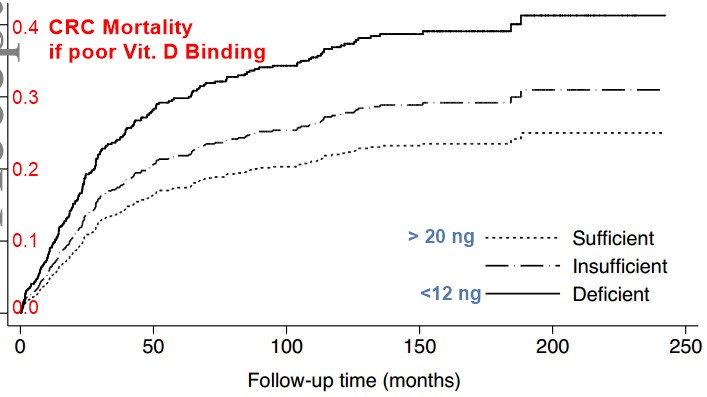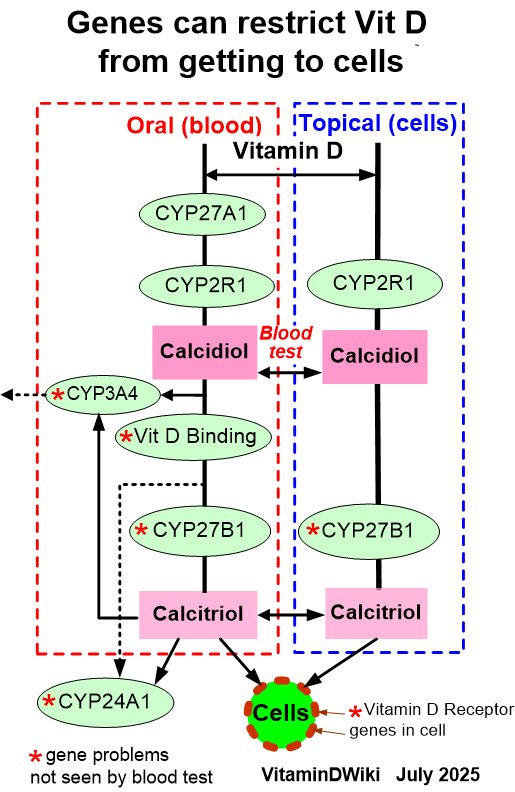Colorectal Cancer death 2.1X more likely if poor Vitamin D plus poor Vitamin D Binding protein
Association of Pre-Diagnostic Vitamin D Status With Mortality Among Colorectal Cancer Patients Differs by Common, Inherited Vitamin D-binding Protein Isoforms
Int J Cancer. 2020 May 11. doi: 10.1002/ijc.33043.

 click on chart for detials
---
* Prostate cancer 3X more likely to be lethal if both low vitamin D and poor Vitamin D Binding gene – March 2020
* Vitamin D Binding Protein masks how much Vitamin D gets to tissues – May 2019
* Poor Vitamin D response 4X more likely if poor Vitamin D binding proteins - July 2019
* 10 reasons for poor response to Vitamin D (race, binding protein, etc.) – Nov 2017
* Colorectal cancer is associated with Vitamin D (17 meta-analyses so far) – July 2018
1. Cancer - Colon category starts with the following
{include}
click on chart for detials
---
* Prostate cancer 3X more likely to be lethal if both low vitamin D and poor Vitamin D Binding gene – March 2020
* Vitamin D Binding Protein masks how much Vitamin D gets to tissues – May 2019
* Poor Vitamin D response 4X more likely if poor Vitamin D binding proteins - July 2019
* 10 reasons for poor response to Vitamin D (race, binding protein, etc.) – Nov 2017
* Colorectal cancer is associated with Vitamin D (17 meta-analyses so far) – July 2018
1. Cancer - Colon category starts with the following
{include}
📄 Download the PDF from Sci-Hub via VitaminDWiki
David Corley Gibbs 1, Roberd M Bostick 1 2, Marjorie McCullough 3, Caroline Um 3, Dana Flanders 1, Mazda Jenab 4, Elisabete Weiderpass 5, Björn Gylling 6, Inger T Gram 7, Alicia K Heath 8, Sandra Colorado-Yohar 9 10 11, Christina C Dahm 12, Bas Bueno-de-Mesquita 13, Aurora Perez-Cornago 14, Antonia Trichopoulou 15, Rosario Tumino 16, Tilman Kühn 17, Veronika Fedirko 1 2
Lower pre-diagnostic circulating 25-hydroxyvitamin D (25[OH]D)-considered the best marker of total vitamin D exposure-is associated with higher mortality risk among colorectal cancer (CRC) patients. However, it is unknown whether this association differs by the vitamin D-binding protein (GC) isoform Gc2 (encoded by GC rs4588C>A, Thr436Lys), which may substantially affect vitamin D metabolism and modify associations of 25(OH)D with colorectal neoplasm risk. Pre-diagnostic 25(OH)D-mortality associations according to Gc2 isoform were estimated using multivariable Cox proportional hazards regression among 1,281 CRC cases (635 deaths, 483 from CRC) from two large prospective cohorts conducted in the United States (Cancer Prevention Study-II) and Europe (European Prospective Investigation into Cancer and Nutrition). 25(OH)D measurements were calibrated to a single assay, season standardized, and categorized using Institute of Medicine recommendations (deficient [<30], insufficient [30 - <50], sufficient [≥50 nmol/L]). In the pooled analysis, multivariable-adjusted hazard ratios (HRs) for CRC-specific mortality associated with deficient relative to sufficient 25(OH)D concentrations were 2.24 (95% CI 1.44-3.49) among cases with the Gc2 isoform, and 0.94 (95% CI 0.68-1.22) among cases without Gc2 (Pinteraction = 0.0002). The corresponding HRs for all-cause mortality were 1.80 (95% CI 1.24-2.60) among those with Gc2, and 1.12 (95% CI 0.84-1.51) among those without Gc2 (Pinteraction = 0.004). Our findings suggest that the association of pre-diagnostic vitamin D status with mortality among CRC patients may differ by functional GC isoforms, and patients who inherit the Gc2 isoform (GC rs4588A) may particularly benefit from higher circulating 25(OH)D for improved CRC prognosis.
